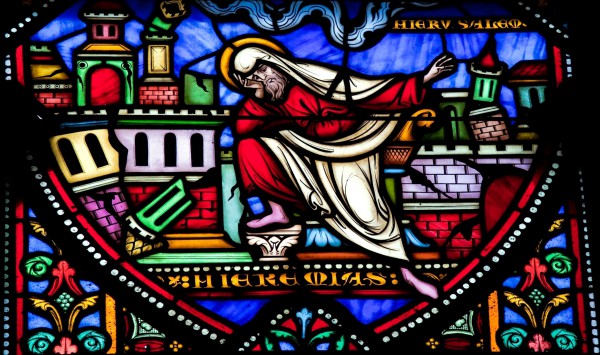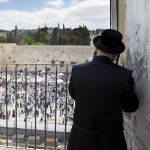
Visitors see the Second Temple as Yeshua (Jesus) may have seen it at the 50:1 scale model in Jerusalem.
“Even so, when you see these things happening, you know that the kingdom of God is near.” (Luke 21:31; see also Matthew 24:33)
Tisha B’Av (the 9th of Av), is almost upon us, the saddest day on the Jewish calendar, which ends three weeks of national mourning for the destruction of the Holy Temples in Jerusalem and other national tragedies.
From sundown on Saturday evening until sundown on Sunday, observant Jews will fast and attend synagogue services where passages from the Book of Lamentations are recited.
This book was written against the background of the destruction of Jerusalem and the Temple by Babylon in 586 BC.
The Mishnah tracks the beginnings of the fast day as going back to the time of the Ten Spies that gave an evil report—that same night the people cried, which was the ninth of Av. This became a day for weeping and misfortune for all of history.
Other events that happened on the last day of the Three Weeks throughout history are also remembered.
Kinnot (sad poems) memorialize the murder of the ten martyred rabbis mentioned in the Mishnah (rabbinic book of oral teachings), as well as medieval Jewish communities that were massacred during the Crusades. On this day in 1096, the Crusades began during which 1.2 million Jews were killed.
Special kinnot are also recited for the victims of the Holocaust. On the 9th of Av, Heinrich Himmler presented the Nazi “Final Solution” to wipe out all Jews in Europe. In 1942, on this same day, the Nazis began to deport all Jews from the Warsaw Ghetto to extermination camps.
In more recent times, the bombing of the Jewish Community Center in Buenos Aires in 1994 took place on the following day or the 10th of Av as did the disengagement from the Gaza Strip in 2005.
The Remedy for Baseless Hatred: Reconstructing the Temple With Love
Tisha B’Av is about much more than mourning the destruction of a glorious work of architecture or the desolation of Jewish real estate.
It is a 25-hour period in which we contemplate the very fragile nature of our existence as the Jewish people and as a nation. As the hearts of many once again are filled with hatred of God’s people, this is a day to call on God to strengthen and sustain us.
Tisha B’Av is also a time in which we are challenged to demonstrate our love for one another, and especially the Jewish People. For as Rabbi Avraham Isaac Kook of the early 20th century declared, “The [Second] Temple was destroyed because of causeless hatred [among Jews]; it can be rebuilt only by causeless love.”
We are reminded of this admonition as the seeds of division are being sown in Israel where so many opinions lash out against people and within political parties with regard to her leaders and what the country needs most.

Two Israeli police officers provide security on the street just outside the Old City of Jerusalem’s Dung Gate, the closest gate to the Western (Wailing) Wall.
Rabbi Kook (1865–1935) explained that “baseless or causeless love” means loving every single Jew, regardless of how they may differ from you politically or religiously.
Taken at face value, this means that despite some extreme differences, left-leaning and right-leaning people, as well as secular Jews and ultra-Orthodox Jews would love one another. It would mean that settlers in disputed territories would love the security forces evicting them from their settlements.
All this might seem impossible, but Rabbi Kook says that’s precisely what is required for us to see the Temple restored in our days.
Of course, before the Second Temple was ever destroyed, Yeshua HaMashiach (Jesus the Messiah) addressed the importance of love, emphasizing that the commandments themselves could be summarized as love God and others. And He gives us a model for how to do that:
“A new command I give you: Love one another, as I have loved you.” (John 13:34)
On Tisha B’Av, We Can Move the Temple Inside
This three-week period has been a time of study, contemplation, and looking within. The goal is improving our character.
As we contemplate our own character and the tragedies connected to the destruction of the Second Temple on Tisha B’Av, hopefully we will work toward Ahavat Hinam (Baseless Love), or love of our fellow man, counteracting Sinat Hinam (Baseless Hatred)—the same baseless hatred that the rabbis believe brought the destruction of the Second Temple.
That Baseless Hatred (Sinat Hinam) might also be translated as Hatred of their Hein or grace, beauty, charm. In other words, Jews hated Jews for the unique good they presented. (LevEchad)
Rebbe Nachman of Breslov also encouraged baseless love as the antidote:
“Even if your brother is a completely wicked person, one needs to search and to find in them a single thing that is not completely evil and in doing so will find goodness and the ability to judge your brother favorably” (Likutei Moharan I:282). (Aish)
The rabbis say that one way to love the unlovable is to seek out the goodness with which God has graced them.
Yeshua emphasized that we must model our love after God’s love. Our love must extend beyond loving those who have the power to reward our love:
“But love your enemies, and do good, and lend, expecting nothing in return; and your reward will be great, and you will be sons of the Most High; for He Himself is kind to ungrateful and evil men. Be merciful, just as your Father is merciful.” (Luke 6:35–36)
According to the rabbis, through changing our feelings toward others the Jewish people will succeed in bringing about the reconstruction of the Temple — physically and spiritually.
Although a physical Temple will be built for the Messiah, His Ruach HaKodesh has already found a home in the bodies of Believers.
“Do you not know that your bodies are temples of the Holy Spirit, who is in you, whom you have received from God? You are not your own.” (1 Corinthians 6:19)
Together with God’s Ruach, we can do miracles — even love the unlovable — because the first fruit of His Ruach is love:
“The fruit of the Spirit is love, joy, peace, forbearance, kindness, goodness, faithfulness …” (Galatians 5:22)

Israelis and tourists visit the Western (Wailing) Wall Plaza, which is beneath the spot on the Temple Mount where the Temples once stood.
All Israel Will Be Saved
The weeks leading up to Tisha B’Av is the time to contemplate the differences that divide us, doctrinal factions, hatred, the state of our own hearts and minds — all these things and more should come under scrutiny.
Through the Torah, God intended to school the world, beginning with Israel, about how to love Him and one another. Of course, God’s intention was that Israel and the entire world experience His Presence.
And God’s Presence did come to rest in the Temple.
But when the Temple was destroyed, this gift of experiencing the Presence of God at His Holy Temple ended. Although the gift of the Ruach HaKodesh (Holy Spirit) was poured out at Shavuot (Pentecost) on the followers of Yeshua, who were primarily Jewish, it has not been poured out over Israel as a nation — yet.
One of the greatest promises in the Brit Chadashah (New Testament) is this:
“All Israel will be saved. As it is written: ‘The deliverer will come from Zion; He will turn godlessness away from Jacob.’” (Romans 11:26; see also Jeremiah 31)
That deliverer is Yeshua HaMashiach, the branch of Jesse (King David’s father) who will restore the Temple:
“Here is the man whose name is the Branch, and He will branch out from His place and build the temple of the LORD. It is He who will build the temple of the LORD, and He will be clothed with majesty and will sit and rule on His throne. And He will be a priest on His throne. And there will be harmony between the two.” (Zechariah 6:12–13)

The Torah scroll is touched with a tallit (prayer shawl) in reverence for God
and the sanctity of His Word. The tallit is then kissed.
While Iran, Hamas, Syria, and most of the Middle East hates Israelis with an irrational, baseless hatred and seeks to infect the entire world with that hatred, you can make a difference by spreading baseless love.
Please lift the Jewish People up in prayer and stand with Israel as it seeks to protect its beleaguered citizens. Israel needs you now!
“Comfort, comfort My people, says your God. Speak tenderly to Jerusalem, and proclaim to her that her hard service has been completed.” (Isaiah 40:1h–2)















